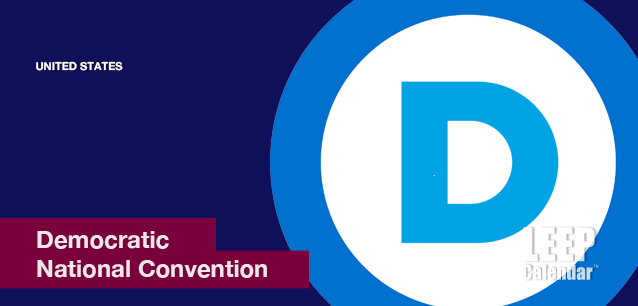 AD
AD
Today is: November 05
Scroll to explore events active on this date.
LEEP INK FEATURES

August? Absolutely!
In August, we live through the Dog Days of Summer. It's hot and often humid, and those who can leave for better climates do. Down south, winter is in full force. August is also known as "the ...

In The Heat of July: July 2025 Events
Is it hot enough (or cold enough if you're below the equator) for you yet? There is actually a day for that! Like every month, I pick a diverse collection of events you may or may not know about. This ...

May Blooms: Events in May 2025
Along with October, May is one of the most densely packed months of the year. It's before the summer humidity and the last whole month of the school year. The weather is warming in t...
About the Democratic National Convention
Rallies & Protests , United States
Ends: Aug 22, 2024
DESCRIPTION:
CHARTING A NEW COURSE:
THE DEMOCRATIC NATIONAL CONVENTION
The Democratic National Convention is where the Democratic Party nominates its Presidential and Vice Presidential candidates for the upcoming election.
Historically, the Democratic Party represented state's rights, populism and the everyman, agriculture and farming, and a limited federal government.
In its first 150 years, it did not support or promote minority rights or ending slavery. Their position changed drastically with the Great Depression and again under the Kennedy and Johnson administrations. If you identify as a Democrat today, you would have most likely been a Republican through the 1920s and vice versa. Both parties switched positions between the 1930s and 1960s due to the Great Depression, Cold War, and the Civil Rights movements.
The following is an overview of some key historical events and changes to the Democratic Party.
Early History: 1800s
Founded in the early 19th century, the Democratic Party evolved out of the Democratic-Republican Party, becoming a champion for states' rights, limited federal government, and rural interests. Many of its leaders, notably Andrew Jackson, embodied populism and support for the "common man," though policies typically excluded minority and marginalized groups.
During the Civil War era, the Democratic Party was heavily aligned with Southern interests, including defending slavery and a state's right to secede. This led to an ideological split between Northern and Southern Democrats (Dixiecrats).
Late 19th to Early 20th Century
After the Civil War, the Democrats continued to represent agrarian and rural interests considering themselves the party of the "little guy" against big business. However, they were intensely active in the South in promoting resistance to civil rights for African Americans, Native Americans, and people of color during the Reconstruction era.
In the early 20th century, Democrats, including Woodrow Wilson, embraced progressive reforms, although a solid conservative wing continued to resist changes. One of these changes was to end free immigration.
Republicans and Democrats were equally responsible for the Emergency Quota Act of 1921 and the Immigration Act of 1924 (Johnson-Reed Act), establishing quota immigration based on national origin that also flagged faith to reduce immigration from non-Protestant religions and people from Southern and Eastern Europe and Asia. It would later be used to limit immigration from Africa and the Americas.
New Deal Era: 1930s - 1940s
Under Franklin D. Roosevelt, the Democratic Party underwent a significant transformation, becoming the party of the New Deal, a series of programs to alleviate the economic and cultural fallout of the Great Depression. This era shifted towards more interventionist government policies and created a broad coalition that included labor unions, minorities, and intellectuals.
Mid to Late 20th Century: 1950s - 1990s
During the civil rights era, the Democratic Party increasingly aligned with the movement for racial equality. Under Lyndon B. Johnson, the party passed landmark civil rights legislation and expanded social welfare programs. The shift towards civil rights led to a realignment, with many Southern whites leaving the Democratic Party for the Republican Party.
This rift is where the Republican Party shifted its platform, picking up the disenchanted and going all-in on traditional and socially religious causes. In the 1990s, under President Bill Clinton, the Democratic Party embraced a more centrist approach, supporting welfare reform, fiscal responsibility, and free trade.
Modern Era:
2000 - 2010
In the 21st century, the Democratic Party has generally aligned with progressive social policies, including gay rights, environmental protection, and healthcare reform.
Under President Barack Obama, the party pursued significant reforms, including the Affordable Care Act. More recently, the party has seen a rise in its progressive wing, advocating for policies like the Green New Deal and Medicare for All. Some of these policies have been well received. Some have not.
2010-Present:
Beginning around 2010, partially in response to the significant upswing in populism within the Republican Party, the Democratic Party made a sharp turn to the left, embracing ideas considered fringe a decade prior. These ideas spread and were reinforced through social media.
During the pandemic years, these ideas went mainstream and are causing divisions and social strife not seen since the 1960s.
Pressures to reformat the English language and impose theoretical ideas on society have divided the Democratic Party. Many centrist and conservative Democrats believe these theories infringe on women's rights to safety and equality in public places, sports, and opportunities. As parents, they feel that the state has overreached its power by undermining their right to raise their children as they see fit.
Debate is discouraged through name-calling and bullying, and the push-back against anyone not promoting and endorsing the new narrative, contrary to the cultivated image of the party, results in public shaming, firings, and violence. Conclusion
The Democratic Party has evolved from its early 19th-century roots as a champion of states' rights, pro-slavery and rural interests to a modern coalition that includes progressives, minorities, labor unions, and others. Key shifts include:
The New Deal policies in the 1930s.
Alignment with the civil rights movement in the 1960s.
The rise of progressive voices relating to existential threats, including climate change, resource allocation, and income inequality.
The adoption and enforcement of social theories on society driven by social media.
Like the Republican Party, changes in the Democratic Party reflect broader trends and transformations in American society, economics, and culture. The Democratic Party is reaching another turning point in the next decade. Which way it goes will be interesting to see.
VIDEOS
SUPPORTING DOCUMENTS
Currently, this event does not have supporting documents.
ADDITIONAL IMAGES
Currently, this event does not have supporting images.
Where would you like to go now?
 AD
AD


/footer-logo.svg)
